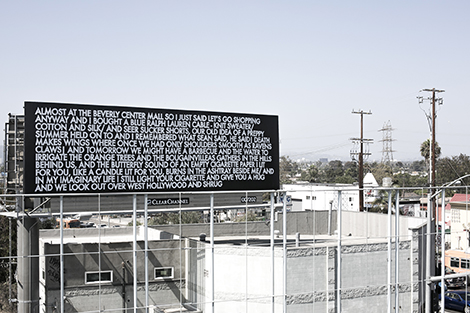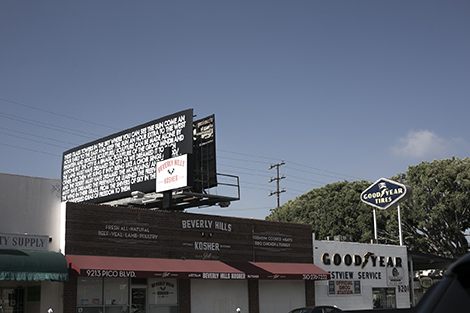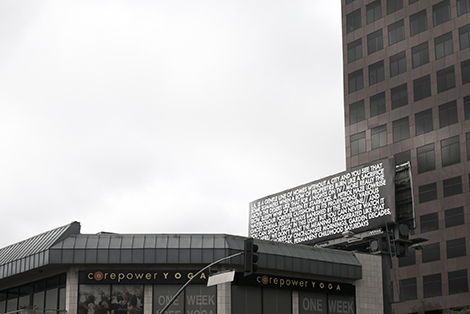This summer, in what seemed like a large seizure of prime advertising real estate, 10 LA billboards were repurposed for an alternative exhibition of text-based artworks by the Scottish artist Robert Montgomery. Sponsored by the Do Art Foundation and Art Share LA, Montgomery’s poetic texts forced viewers to consider something deeper than the usual plastic and perfection. Strategically placed in busy neighborhoods and high-traffic areas, these billboards were designed not only to invade the peripheral vision of commuters en route to their destinations, but also to infiltrate the city’s collective consciousness with emotion and meaning, even if just for a moment.
Borrowing a great tactic that the advertising industry, in turn, adopted from street art, and without much introduction, Montgomery’s entire installation appeared overnight, leaving Angelenos incredibly curious. There was a buzz amongst LA residents before there was an explanation. It was as if a new kind of corporate-sponsored street art vying for attention in an already oversaturated town suddenly identified the feelings of emptiness embedded in the perpetual rat race. The text-heavy, hard-to-read billboards were aesthetically simple—crowded white letters densely placed on a black background. Yet Montgomery touches on something advertising typically does not: self-deprecation and introspection through literary prose. It takes time to read and time to ingest, and that is what made people stop and stare.
With nods to Barbara Kruger, Jenny Holzer and The Situationists, Montgomery seems to explore the notion of revolution while also instigating rebellion and forcing viewers to reconsider their busy, impersonal LA lifestyles. The Situationists, prevalent in the 1950s and ’60s, were an under-recognized anti-art, anti-movement, revolutionary group of painters, writers, architects and filmmakers interested in Marxism and intense psychoanalysis, mixed with a whimsical Surrealist-inspired take on everyday life. Criticizing manufactured beauty, the movie industry, ever-increasing technological obsession and the forced self-satisfaction amongst Angelenos, Montgomery pulls on the heart strings of viewers while also stroking their egos: The poems are intimate and feel like little treasures found uniquely by each viewer.
Montgomery certainly isn’t the first to infiltrate public spaces with word-based art, but his direction seems different than that of other artists working in this medium. Montgomery is also an editor for the London-based magazine Dazed & Confused and considers himself a writer first and foremost. The tops of buildings, large billboards, empty fields and even bus stops spread his intimate, self-reflective poetry to an international audience.
This exhibition was his first in the City of Angels, and though he has public-ally expressed distaste for the hyper-fake, consumer-based LA culture, his site-specific works feel connected and inspired by the SoCal existence.
Montgomery effects a kind of subversive manipulation with his free-verse poetry and stylized confessional prose—he aims his work directly at the heart of the viewer, leading with self-deprecation and romantic abandon while simultaneously critiquing the realities of our contemporary, media-saturated lives.




